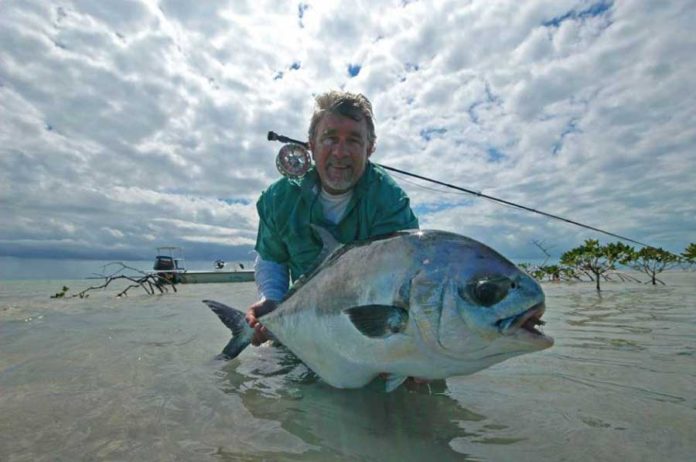Most fly fishers consider the permit to be among the wariest and toughest fish on the flats, and catching one on a fly is the pinnacle of an angler’s career.
The permit’s Latin name, Trachinotus falcatus, identifies the species as a real warrior. Trachinotus is a fusion of Greek words that mean “rough back,” while falcatus is a Latin adjective that translates roughly to “armed with scythes.” Anglers who target permit, which are notoriously finicky and dogged fighters, had better be armed with superior skills, limitless patience, and a high tolerance for failure.
Range and Habits
Permit are native to the western Atlantic and range from Massachusetts south to Brazil. Although the species has been reported in the eastern Atlantic, biologists do not believe the fish occur regularly there. The largest populations of permit are in southern Florida, but good numbers of fish can be found throughout the Caribbean and the Gulf of Mexico.
Adult permit inhabit inshore waters, spending most of their time in deep cuts, holes, and channels adjacent to flats. When the tide covers the flats, the fish move up into the shallow water to feed—often cruising in water so shallow that their distinctive dorsal fins are exposed. On the flats, permit usually travel in small schools, although larger specimens may be solitary. They can also be found in deep water, forming large schools that congregate around structures such as reefs, wrecks, and jetties.
Permit are opportunistic feeders, using their hard mouths to dig in the seabottom and root our prey such as mollusks, crabs, and small fish. They’ll also eat sea urchins. Most anglers use crab patterns to tempt cruising fish.
Giants of the Flats
The recognized all-tackle record for permit is a 60-pound monster caught by Renato Fiedler at Ilha do Mel, Paranagua, Brazil in 2002. The largest fly-caught fish is the subject of some debate. Del Brown’s 41-pound, 8-ounce Key West fish has stood since 1986, but in 2003, Rhode Island native Brian Eliason landed and released a 51-pound behemoth in the Keys. The International Game Fish Association at first awarded Eliason the world-record, but later rescinded it because they said there was not enough information to verify it.
It’s fitting that Brown, who died in 2003, holds the record, since he was the most dedicated permit fisherman in history. Whereas most anglers would be thrilled to catch just one of these elusive fish, Brown boated an astounding 513 permit in his lifetime. His Del’s Merkin crab imitation is among the more popular permit patterns of all time.
Conservation
Most anglers will be astonished to discover that Florida allowed commercial fishing for permit until 2011. Organizations such as Bonefish & Tarpon Trust are lobbying hard to make permit catch-and-release, based on the argument that—as part of the economic contribution of sport fishing, estimated at more than $8 billion per year—permit are far more valuable alive than dead. Working with the Florida Fish and Wildlife Conservation Commission, BTT established a Special Permit Protection Zone encompassing the Florida Keys. In this zone, permit harvest is closed during their spawning season. Because so little is known about the permit life cycle and the size of stocks, much more research is necessary.
Credit: Source link






























